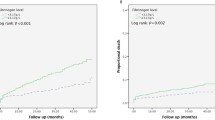Abstract
Fibrinogen, an inflammatory marker as well as a fundamental part of the coagulation cascade, is suggested to play a significant role in the pathogenesis of atherosclerosis and complications of atherothrombotic diseases. The aim of this study was to determine if plasma fibrinogen is an independent risk factor for long-term survival in patients with peripheral artery disease (PAD). Altogether, 139 Chinese patients (88 men, 51 women) with PAD were consecutively recruited for the study. Atherothrombotic risk factors and fibrinogen levels were determined at presentation, and all patients were followed up for mortality prospectively. The mean follow-up was 6 years. All variables were first correlated with survival rates using Kaplan-Meier analysis and compared by means of the log-rank test. Significant risk factors were identified, and multivariate Cox regression analysis was used to evaluate the independent contribution of the fibrinogen level to the risk of mortality. During follow-up, 95 patients (68.3%) died. The overall survival rate was 77.7% at 3 years, 56.8% at 5 years, and 31.2% at 10 years (standard errors 0.05, 0.06, and 0.07, respectively). All-cause mortality rate increased with an elevated fibrinogen level. Eighty percent of patients with a fibrinogen level > 3.4 g/L had a survival time of less than 3 years (p = 0.002). This relation was also demonstrated within patients with critical ischemia. The plasma fibrinogen level was thus identified as an independent risk factor for mortality in PAD patients after adjusting for confounding factors.


Similar content being viewed by others
References
Smith FB, Lee AJ, Hau CM, et al. Plasma fibrinogen, hemostatic factor and prediction on peripheral artery disease in the Edinburgh Artery Study. Blood Coagul. Fibrinolysis 2000;11:43–50
Bombeli T, Schwartz BR, Harlan JM. Adhesion of activated platelets to endothelial cells: evidence for a GPIIbIIIa-dependent bridging mechanism and novel roles for endothelial intercellular adhesion molecule 1 (ICAM-1), alphavbeta 3 integrin, and GPIbalpha. J. Exp. Med. 1998;187:329–339
Di Minno G, Mancini M. Measuring plasma fibrinogen to predict stroke and myocardial infarction. Arteriosclerosis 1990;10:1–7
Mannucci PM, Recent progress in the pathophysiology of fibrinogen. Eur. Heart J. 1995;16:25–30
Glass CK, Witztum JL. Atherosclerosis: the road ahead. Cell 2001;104:503–516
Lusis AJ Atheroslceorsis. Nature 2000;407:233–241
Libby P, Ridker PM, Maseri A. Inflammation and atherosclerosis. Circulation 2002;105:1135–1143
Blak GJ, Ridker PM. Novel clinical markers of vascular wall inflammation. Circ. Res. 2001;89:763–771
Doweik L, Maca T, Schillinger M, et al. Fibrinogen predicts mortality in high risk patients with peripheral artery disease. Eur. J. Vasc. Endovasc. Surg. 2003;26:381–386
Rutherford RB, Baker JD, Ernst C, et al. Recommended standards for reports dealing with lower extremity ischemia: revised version. J. Vasc. Surg. 1997;26:517–538
Lam TH, Liu LJ, Janus ED, et al. Hong Kong Cardiovascular Risk Factor Prevalence Study Steering Committee. Fibrinogen, other cardiovascular risk factors and diabetes mellitus in Hong Kong: a community with high prevalence of type 2 diabetes mellitus and impaired glucose tolerance. Diabet. Med. 2000;17:798–806
Van Den Biggelaar AH, De Craen AJ, Gussekloo J, et al. Inflammation underlying cardiovascular mortality is a late consequence of evolutionary programming. FASEB J. 2004;18:1022–1024
Ernst E, Koenig W. Fibrinogen and cardiovascular risk. Vasc. Med. 1997;2:115–125
Margaglione M, Grandone E, Mancini FP, et al. Genetic modulation of plasma fibrinogen concentrations: possible importance of interleukin-6. J. Thromb. Thrombolysis 1996;3:51–56
Ernst E. Regular exercise reduces fibrinogen levels: a review of longitudinal studies. Br. J. Sports Med. 1993;27:175–176
Behague I, Poirier O, Nicaud V, et al. Beta-fibrinogen gene polymorphisms are associated with plasma fibrinogen and coronary artery disease in patients with myocardial infarction: the ECTIM study. Circulation 1996;93:440–449
Tracy RP. Epidemiological evidence for inflammation in cardiovascular disease. Thromb. Haemost. 1999;82:826–831
The I.C.A.I. Group. Long-term mortality and its predictors in patients with critical leg ischemia. Eur. J. Vasc. Endovasc. Surg. 1997;14:91–95
O’Malley T, Langhorne P, Elton RA, et al. Platelet size in stroke patients. Stroke 1995;26:995–999
Martin JF, Bark PM, Burr ML. Influence of platelet size on outcome after myocardial infarction. Lancet 1991;338:409–411
Turczynski B, Slowinska L, Szczesny S, et al. The whole blood and plasma viscosity changes in course of acute myocardial infarction. Pol. Arch. Med. Wewn. 2002;108:971–978
Cheng SWK, Ting ACW, Wong J. Fasting total plasma homocysteine and atherosclerotic peripheral vascular disease. Ann. Vasc. Surg. 1997;11:217–223
Anderson JL, Muhlestein JB, Home BD, et al. Plasma homocysteine predicts mortality independently of traditional risk factors and C-reactive proteins in patients with angiographically defined coronary artery disease. Circulation 2000;102:1227–1232
Eikelboom JW, Lonn E, Genest J Jr, et al. Homocysteine, and cardiovascular disease: a critical review of the epidemiologic evidence. Ann. Intern. Med. 1991;131:363–375
Critchley JA, Unal B. Is smokeless tobacco a risk factor for coronary heart disease? A systematic review of epidemiological studies. Eur. J. Cardiovasc. Prev. Rehabil. 2004;2:101–112
Germing A, von Dryander S, Machraoui A, et al. Hyperfibrinogenemia increases the risk of cardiac events after coronary artery stenting. Heart Vessels 2000;6:263–267
Salomaa V, Matei C, Aleksic N, et al. Cross-sectional association of soluble thrombomodulin with mild peripheral artery disease; the ARIC study: atherosclerosis risk in community. Atherosclerosis 2001;157:309–314
Wada H, Mori Y, Okabayashi K, et al. High plasma fibrinogen level is associated with poor clinical outcome in DIC patients. Am. J. Hematol. 2003;72:1–7
Liu Y, Saha N, Heng CK, et al. Fibrinogen genotypes (α and β) are associated with plasma fibrinogen levels in Chinese. J. Med. Genet. 2001;38:E1
Kobayashi S, Inoue N, Ohashi Y, et al. Interaction of oxidative stress and inflammatory response in coronary plaque instability: important role of C-reactive protein. Arterioscler. Thromb. Vasc. Biol. 2003;23:1398–1404
Author information
Authors and Affiliations
Corresponding author
Rights and permissions
About this article
Cite this article
Cheuk, B.L., Cheung, G.C., Lau, S.S. et al. Plasma Fibrinogen Level: an Independent Risk Factor for Long-term Survival in Chinese Patients with Peripheral Artery Disease?. World J. Surg. 29, 1263–1267 (2005). https://doi.org/10.1007/s00268-005-7802-4
Published:
Issue Date:
DOI: https://doi.org/10.1007/s00268-005-7802-4




